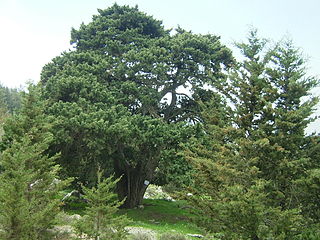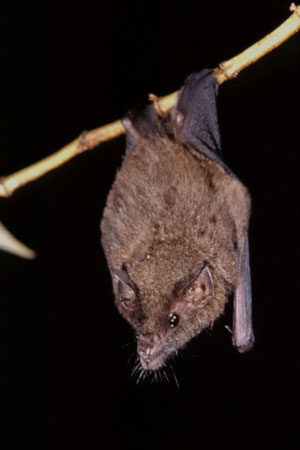
Cupressus is one of several genera of evergreen conifers within the family Cupressaceae that have the common name cypress; for the others, see cypress. It is considered a polyphyletic group. Based on genetic and morphological analysis, the genus Cupressus is found in the subfamily Cupressoideae. The common name "cypress" comes via the Old French cipres from the Latin cyparissus, which is the latinisation of the Greek κυπάρισσος (kypárissos).

Tsuga is a genus of conifers in the subfamily Abietoideae of Pinaceae, the pine family. The common name hemlock is derived from a perceived similarity in the smell of its crushed foliage to that of the unrelated plant poison hemlock. Unlike the latter, Tsuga species are not poisonous.

The New Guinea big-eared bat or Papuan big-eared bat,, is a vesper bat endemic to Papua New Guinea. It is listed as a critically endangered species due to ongoing habitat loss. It is the only known member of the genus Pharotis, which is closely related to Nyctophilus.
Aphloia is a genus of flowering plants that contains a single species, Aphloia theiformis, the sole species of the monogeneric family Aphloiaceae. It is a species of evergreen shrubs or small trees occurring in East Africa, Madagascar, the Mascarene Islands and the Seychelles.

Anoura is a genus of leaf-nosed bats from Central and South America. Anoura members lack or have a short tail, and are nectarivorous bats of small to medium size among the Phyllostomidae.

The northern broad-nosed bat is a species of the vespertilionid family of microbats. It can be found in northern Australia, Timor-Leste, and Papua New Guinea.
The western false pipistrelle, species Falsistrellus mackenziei, is a vespertilionid bat that occurs in Southwest Australia. The population is declining due to loss of its habitat, old growth in tall eucalypt forest which has largely been clear felled for tree plantations, wheat cultivation and urbanisation. Although it is one of the largest Australian bats of the family, the species was not recorded or described until the early 1960s. A darkly colored bat with reddish brown fur and prominent ears, they fly rapidly around the upper canopy of trees in pursuit of flying insects.
The inland forest bat is a vesper bat that occurs in central and arid regions in Australia. They were first described in 1987, published in a review of poorly surveyed microbat populations. A tiny flying mammal, it occupies small cavities in trees and buildings while roosting. The nocturnal activity is foraging for insects, typically moths.
Nephelomys levipes, also known as the nimble-footed oryzomys or light-footed rice rat, is a species of rodent in the genus Nephelomys of family Cricetidae. It is found on the eastern slope of the Andes from southeastern Peru into west-central Bolivia in cloud forest at elevations from 1,800 to 3,200 metres. It occurs in the same general area as its congener N. keaysi, but at higher altitudes.

True's shrew mole is a species of mammal in the family Talpidae. It is endemic to Japan and is a common species above 1000 meters in grassland, shrubland and forest. Sometimes this species is called the lesser Japanese shrew mole and another species, Urotrichus talpoides, is called the "greater Japanese shrew mole".

The lesser yellow-shouldered bat is a species of bat in the family Phyllostomidae. It is native to Peru and Ecuador. It is threatened by habitat loss.

Acherontemys is an extinct genus of turtle from Eocene sediments in northwestern North America and comprising a single species Acherontemys heckmani. Acherontemys has been placed within the pond turtle superfamily Testudinoidea as part of the clade Pan-Emydidae.
Apororhynchus is a genus of small parasitic spiny-headed worms. It is the only genus in the family Apororhynchidae, which in turn is the only member of the order Apororhynchida. A lack of features commonly found in the phylum Acanthocephala suggests an evolutionary branching from the other three orders of class Archiacanthocephala; however no genetic analysis has been completed to determine the evolutionary relationship between species. The distinguishing features of this order among archiacanthocephalans is a highly enlarged proboscis which contain small hooks. The musculature around the proboscis is also structured differently in this order. This genus contains six species that are distributed globally, being collected sporadically in Hawaii, Europe, North America, South America, and Asia. These worms exclusively parasitize birds by attaching themselves around the cloaca using their hook-covered proboscis. The bird hosts are of different orders, including owls, waders, and passerines. Infestation by an Apororhynchus species may cause enteritis and anemia.
Reigomys primigenus is an extinct oryzomyine rodent known from Pleistocene deposits in Tarija Department, southeastern Bolivia. It is known from a number of isolated jaws and molars which show that its molars were almost identical to those of the living Lundomys. On the other hand, the animal possesses a number of derived traits of the palate which document a closer relationship to living Holochilus, the genus of South American marsh rats, and for this reason it was placed in the genus Holochilus when it was first described in 1996. The subsequent discoveries of Noronhomys and Carletonomys, which may be more closely related to extant Holochilus than H. primigenus is, have cast its placement in Holochilus into doubt, and it was ultimately made the type species of a separate genus, Reigomys.
Petenaea cordata was first described in Elaeocarpaceae and later placed in Tiliaceae, but most authors have been uncertain about its familial affinities. It was considered a taxon incertae sedis in the Angiosperm Phylogeny Group classification. Molecular analyses based on a recent collection from Guatemala indicate a distant, weakly supported sister-group relationship to the African genus Gerrardina. As no obvious synapomorphies exist for Gerrardina and Petenaea, the new monogeneric family Petenaeaceae was proposed. The polymorphic order Huerteales now comprises four small families: Dipentodontaceae, Gerrardinaceae, Petenaeaceae and Tapisciaceae. Petenaea cordata is the only species in the genus Petenaea.
The Turkestani long-eared bat is a species of bat found in Asia. Though it was initially described in 1873 as a species, for many years it was considered synonymous with the desert long-eared bat, Otonycteris hemprichii. Recently, it was recognized as a distinct species once again.
Rosevear's serotine is a species of vesper bat that lives in Guinea and Liberia. It was described as a new species in 2013. It is listed as endangered by the IUCN.

The long-toothed pipistrelle is a species of bat of the genus Hypsugo. It is a small bat, with a length of 35.2–38.4 mm of forearm, and 5.9–7 mm of foot. It feeds on insects and has especially long canines compared to others of its genus.

Aspidytidae is a family of aquatic beetles of the suborder Adephaga, described in 2002 from specimens in South Africa and China. There are only two known species in the family and these were originally described in the genus Aspidytes, but later the new genus Sinaspidytes was erected for the species found in China. The family can also be referred to by its trivial name cliff water beetles.

Ormenoides venusta is a species of flatid planthopper in the family Flatidae, found in North America. This species is univoltine, with first instars emerging in May. It feeds on paw paw leaves.












